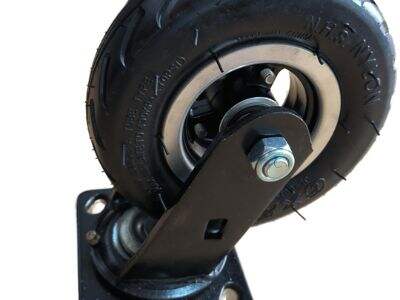PU-Foam-Räder im Vergleich zu Gummirädern. PU-Foam-Räder und Gummiräder sind zwei oft verwendete Raddesigns bei verschiedenen Geräten. Hier sind einige Dinge, die Sie berücksichtigen sollten, um zu entscheiden, welche Art am besten für Sie geeignet ist: Lassen Sie uns die Vorteile von PU-Foam-Rädern und Gummirädern sowie wie man das richtige Rad für Ihre Bedürfnisse auswählt, überprüfen.
PU-Foam-Räder: Einige Vorteile für eine ruhigere Fahrt
PU-Foam-Räder (auch als feste Polyurethanräder bekannt) werden sehr nachgefragt, da sie eine bequeme Fahrt bieten. Diese Räder bestehen aus dickem Schaumstoff, der Schlaglöcher und Erschütterungen von unebenen Oberflächen absorbiert. PU-Foam-Räder eignen sich für Dinge wie Schubkarren und Handkarren, die möglicherweise über unebenes Gelände fahren oder durch die Nutzung Schaden nehmen könnten.
PU-Foam-Räder sind außerdem sehr robust. PU-Foam-Räder können nicht wie Gummiräder geplatzt werden und benötigen keinen Luftdruck zum Betrieb, im Gegensatz zu Gummirädern, die Löcher bekommen oder mit der Zeit abnutzen können. Daher müssen Sie sich bei der Nutzung von PU-Foam-Rädern keine Sorgen um Platten machen.
Gummi-Räder: Zugfestigkeit und Grip-Vergleich
Gummi-Räder sind robust und bieten einen guten Grip. Diese Räder bestehen aus haltbarem Gummi, um rauhe Gelände außerhalb von Straßen zu bewältigen und in unterschiedlichen Bedingungen einen hervorragenden Grip zu bieten. Gummi-Räder werden auch häufig bei Rasenmähern, Karren und Wagen eingesetzt, wo maximale Haftung und Haltbarkeit entscheidend ist.
Gummi-Räder sind naturgemäß äußerst RAUH und STARK, können aber immer Löcher bekommen und tragen sich schneller ab im Vergleich zu PU-Schaumrädern. Im Laufe der Zeit können Gummi-Räder rissig oder mit Löchern werden, was dazu führen kann, dass sie weniger effektiv arbeiten. Da Gummi-Räder platt gehen können, muss die Luft drin überprüft werden, und einige Benutzer finden das lästig.
Der Grund, warum PU-Schaumräder leichtgewichtig und einfach zu warten sind
Während der Verwendung von PU-Schaumrädern ist einer der Hauptvorteile die Tatsache, dass sie im Vergleich zu Gummireifen leichter sind. Dadurch sind sie portabler und besser handhabbar. Dies ist insbesondere nützlich für Ausrüstung, die Sie häufig heben oder bewegen, da das reduzierte Gewicht die Arbeit erleichtert.
PU-Schaumräder erfordern auch wenig Wartung. Sie benötigen keine Luft, daher müssen Sie sich nie um den Reifendruck kümmern oder ihn anpassen. Das kann Zeit sparen, da Sie sich nicht mit dem Aufpumpen von Reifen oder dem Austausch platter Reifen beschäftigen müssen. PU-Schaumräder ermöglichen es Ihnen, sie anzubringen und sie dann zu vergessen, sodass Sie arbeiten und nie anhalten müssen.
PU-Schaum oder Gummi – Welches Rad ist besser für welche Bedingungen?
Denken Sie darüber nach, wo Sie die Ausrüstung einsetzen werden, wenn Sie zwischen PU-Schaumrädern und Gummirädern wählen. PU-Schaumräder funktionieren besser im Innenraum oder auf glatten Oberflächen, wenn Sie eine gepolsterte Fahrt wünschen. Sie eignen sich auch für leichte Arbeiten, die kein schweres Heben oder häufige Nutzung erfordern.
Gummi-Räder eignen sich besser für den Einsatz im Freien oder auf rauen Geländebeschaffenheiten. Gummi-Räder sind dafür bekannt, einen sicheren Grip auf verschiedenen Oberflächentypen zu bieten, und sie bieten eine überlegene Haftung; daher sind sie ideal für schwere Arbeiten oder Geräte, die für anspruchsvolle Einsatzfälle verwendet werden. Wenn Sie Räder benötigen, die rauen Behandlungen standhalten und gleichzeitig einen stabilen Fahrkomfort bieten, können Gummireifen eine vorzuziehende Wahl sein.
PU-Schaumrad im Vergleich zu Gummireifen hinsichtlich Preis und Haltbarkeit
Kontaktwalze haben Vor- und Nachteile in Bezug auf Kosten und Haltbarkeit. PU-Schaumräder sind im Allgemeinen günstiger als Gummireifen. Da PU-Schaumräder äußerst robust sind, können sie eine lange Lebensdauer haben, da sie nicht so leicht platzen oder abgenutzt werden.
Gummi-Räder sind zwar zunächst teurer. Ihre immense Stabilität und Haftung können sie jedoch zu einer großartigen Investition machen, wenn Sie verlässliche Räder für anspruchsvolle Einsatzbedingungen benötigen. Gummi-Räder erfordern zwar mehr Pflege, aber sie halten länger und leisten in anspruchsvolleren Umgebungen bessere Dienste.
Strandballonrad sind speziell entwickelt worden, um in einer Vielzahl von Situationen besseren Grip zu bieten. Es gibt Vorteile und Nachteile bei beiden Arten von Rädern. Überlegen Sie, wo Sie diese einsetzen werden, welche Art von Arbeit Sie ausführen werden und was für Sie am wichtigsten ist. Ein solides Radset sorgt dafür, dass Sie Ihre Projekte mit Leichtigkeit und Effizienz meistern.
Table of Contents
- PU-Foam-Räder: Einige Vorteile für eine ruhigere Fahrt
- Gummi-Räder: Zugfestigkeit und Grip-Vergleich
- Der Grund, warum PU-Schaumräder leichtgewichtig und einfach zu warten sind
- PU-Schaum oder Gummi – Welches Rad ist besser für welche Bedingungen?
- PU-Schaumrad im Vergleich zu Gummireifen hinsichtlich Preis und Haltbarkeit
 EN
EN
 AR
AR
 BG
BG
 HR
HR
 CS
CS
 DA
DA
 NL
NL
 FI
FI
 FR
FR
 DE
DE
 EL
EL
 HI
HI
 IT
IT
 JA
JA
 KO
KO
 NO
NO
 PL
PL
 PT
PT
 RO
RO
 RU
RU
 ES
ES
 SV
SV
 TL
TL
 ID
ID
 LV
LV
 LT
LT
 SR
SR
 SK
SK
 UK
UK
 VI
VI
 HU
HU
 MT
MT
 TH
TH
 TR
TR
 MS
MS
 GA
GA
 KA
KA
 LA
LA
 NE
NE
 UZ
UZ

